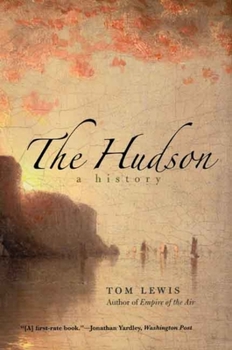The Hudson: A History
Select Format
Select Condition 
Book Overview
A vivid history of the Hudson River and how it has fired the American imagination for four hundred years
Format:Paperback
Language:English
ISBN:0300119909
ISBN13:9780300119909
Release Date:March 2007
Publisher:Yale University Press
Length:352 Pages
Weight:1.10 lbs.
Dimensions:0.9" x 6.2" x 9.1"
Customer Reviews
5 ratings
Happy Nana
Published by Thriftbooks.com User , 16 years ago
Gives SUCH detail about the beautiful Hudson Valley that one becomes very informed about its history. Perfect for not only the American History buff but any one who has lived in NYC, Westchester, Putnam and Dutchess Counties.
How the Hudson Mirrors the Growth and Change in America
Published by Thriftbooks.com User , 18 years ago
Lewis has written a metaphor for the growth of america from an untamed wilderness, to a economic (water) highway, to an industrial giant, to an environmental success story. Lewis takes us through a series of vignettes that tell the history of the changes to the river. It was first to be the way in which trappers and traders were able to get into the interior of the continent for furs. Later it became the source of bringing lumber down to the mills. It was a major battlefield during the Revolution and by protecting it we were able to keep the British from splitting the colonies in two. With the building of the Erie Canal it became the conduit to and from the Great Lakes region for raw materials and finished products. The steamboat and railway made the whole area of the hudson river valley available for settlement and the burgeoning of industry along it's shore. Unlike most east coast rivers, it was navigable for hundreds of miles; with great natural resources of streams for mills, wood for charcoal, deposits of clay it became a major industrial area in the nineteenth century (and a major source of pollution). By the early twentieth century, the river was a polluted nightmare, with large areas unusable and without fish. The river had been polluted with PCB's and the discharge of raw sewage from many of the surrounding towns and cities. In the 1960's when the electric supplier wanted to build a retaining pond for eight billion gallons of water and destroy half of Storm King mountain, people finally began to take notice. The Hudson was the first big victory for the forces of environmental protection that would lead to the creation of the "Superfund". Today the water is cleaner than its' been in a century and can be looked at as an example of how man and nature can live in harmony again.
Fascinating though some slow going
Published by Thriftbooks.com User , 18 years ago
Every student remembers the famous sale of Manhattan Island by the Indians to the Dutch for a few dollars worth of trinkets, but what you may not recall is the native Indians lived in an expanse of territory that strected throughout the Northeast and to them, it was amazing that anyone would pay for one small island. They may have gotten the better deal at the time. The booked is filled with fascinating pieces of history and you will soon learn that the Hudson River is linked to the very foundations of our country. You will also learn that all those street names and highway names in New York stem from the state's very rich history with the Dutch and the English. Some parts of the story are a bit dry, no doubt, but the book is worth reading for the highlights.
shaping America - an engaging tale of the Hudson river's role
Published by Thriftbooks.com User , 19 years ago
This is a charming book - well written and engaging, and wonderful in how it pulls together so many diverse threads, from geology to military history to environmental policy to art history to economics. And although my eyes glazed over a little when the book discusses intricacies of the Dutch poltroon families upstate (my main interest as a New Yorker is recognizing them as Manhattan street names) I think the work is broad in its appeal. Lewis's argument that the Hudson river has been central to shaping American history and culture is compelling and evocatively set forth. My main criticism is the lack of visual accompaniment. This river has inspired extraordinary maps, documents, photographs, and paintings - a whole "school" of art for goodness sake - giving us just handful of postage stamp black and white reproductions in the book is a missed opportunity. The paucity of imagery is really a demerit.
Tales From The Hudson River Valley
Published by Thriftbooks.com User , 19 years ago
This is the perfect book to take along for a car trip on Route 9 or a train trip on the Metro North Hudson Line or any fall vacation along the Hudson River Valley. It is a miracle that suburban sprawl has not destroyed the beauty that the American artists of the Hudson River School painted in the mid-1800's. Mr. Lewis tells the tales of how the Hudson River avoided that fate through the centuries. "The Hudson : A History" is a collection of historical vignettes collected and written in a storytelling style by Mr. Lewis. This book is not the definitive account of the Hudson River -- only the events that Mr. Lewis found most interesting to him. Fortunately, the reader will find them to be interesting and well-told as well. As a follow-up, the reader is referred to "Hudson River Journey" (2003), a beautiful collection of 100+ photographs with a brief background of and driving directions to each photo.






